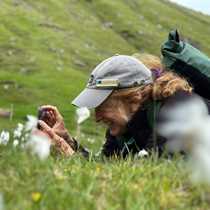The Dalles
How much attention do we pay to the details surrounding us? How many of us realized this morning that the hillsides had a small sprinkling of trees? A rare commodity these past few days as we have navigated on the Columbia and Snake Rivers east of the Cascade Mountains. Meriwether Lewis was glad for the trees when he and the Corps came into the area known today as The Dalles. He noted a fine morning and sent hunters out for deer and to collect “rozin.” They needed the pine pitch for patching up their canoes, which were leaking fairly well now after traveling westward through “ agitated guts swelling, boiling & whirling in every direction.”
Lewis was meticulous for details. Botanists reading the journals, but lacking a specimen, can still identify a plant with the tool of Lewis’ precise narrative. Do you know how many scutes are on the belly of a gopher snake? Do you know the number of tail feathers on a sage grouse? Using such comparisons from his knowledge base, Lewis could recognize a new species and would use these comparatives in his descriptions of new plant, mammal, bird, reptile and fish species.
On June 16, 1806, Lewis writes of the grazing conditions for the horses, the status of the hunters and makes note of the latest flowers emerging, among them blue bells, a yellow flowering pea and a “Cullumbine;” the same species of columbine that we discovered during our explorations and share in our photo today. A diminutive, charming detail of spring that makes you pause for a moment and look at the splendor held in a spring flower.
How much attention do we pay to the details surrounding us? How many of us realized this morning that the hillsides had a small sprinkling of trees? A rare commodity these past few days as we have navigated on the Columbia and Snake Rivers east of the Cascade Mountains. Meriwether Lewis was glad for the trees when he and the Corps came into the area known today as The Dalles. He noted a fine morning and sent hunters out for deer and to collect “rozin.” They needed the pine pitch for patching up their canoes, which were leaking fairly well now after traveling westward through “ agitated guts swelling, boiling & whirling in every direction.”
Lewis was meticulous for details. Botanists reading the journals, but lacking a specimen, can still identify a plant with the tool of Lewis’ precise narrative. Do you know how many scutes are on the belly of a gopher snake? Do you know the number of tail feathers on a sage grouse? Using such comparisons from his knowledge base, Lewis could recognize a new species and would use these comparatives in his descriptions of new plant, mammal, bird, reptile and fish species.
On June 16, 1806, Lewis writes of the grazing conditions for the horses, the status of the hunters and makes note of the latest flowers emerging, among them blue bells, a yellow flowering pea and a “Cullumbine;” the same species of columbine that we discovered during our explorations and share in our photo today. A diminutive, charming detail of spring that makes you pause for a moment and look at the splendor held in a spring flower.




